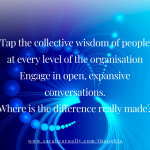
What can virtual meetings teach us about communicating effectively?
In this new way of working there are many who are missing the physical presence of people in meetings. They have noticed the challenge of not having all the natural human interactions and rejoinders – and find their own responses have been subdued or find themselves experiencing moments of doubt and separation.
As a race, humans have tended to be very dependent upon physical contact and as a result we’re wedded to the idea that we have to be in someone’s physical presence in order to sense what’s going on both for ourselves and others. So shifting to this way of operating, using online meeting platforms like Zoom or Teams, will feel hard and taxing if you’re trying to use your old methods of communication.
However, what if working with online meeting platforms is actually an opportunity to take your communication to another level; to develop a new consciousness around communication? It certainly seems to require of us to adopt a greater presence; an increased self-awareness and concentration to be more in the present moment. It’s clear that a new level of capability is required.
This is an important developmental edge. We need to learn how to connect and attune through this medium. It’s tempting to think that this is dependent on learning how to convey everything through our voice. And there’s certainly a requirement of us to consider the quality of our voice and intentionally transmit the purpose behind what we say. In this new medium it’s more important than ever to be authentic – doing so will transmit through your voice and convey what’s important, which will positively impact others. Being relaxed and centered, being attentive, calm and present will allow your voice to transmit in an easy fluid way. It’s about managing what’s going on on the inside so that when you’re communicating, the clarity of what you’re sharing is transmitted.
What online meeting platforms require of us, is an elevated mindfulness of the micro cues that are occurring on the screen – people’s voices, movements in the background, noticing whether people are using the camera, talking with mute turned on, subtle signs on someone’s face – all these micro cues are of higher importance, which can be a valuable source of enquiry.
So whilst online meeting platforms are moving us away from physical proximity – there may be a silver lining in that. Being in a room with a group of people can be distracting on both sides – online meeting platforms have a distillation effect. Having meetings on screen can actually mean that you see more. In a room you might miss, say, seeing the face of the person you’re sitting next to. But with everyone’s face on screen – of equal size – you can’t miss anybody. And if we see signs of disquiet, or dissension, or subtle reactions, the onus is on you to notice, observe and respond accordingly.
There’s a wealth of information available, if you pay attention to the information that is right in front of you. Because now it’s visible on a screen, in front of you – not out of your peripheral vision – it’s crystalised as an additional resource.
Leaders who think that showing up to online meetings and just listening to the information or content is enough, will miss a level of leadership capacity which other leaders are able to access right now. You will be leaving lots of data out of consideration.
So, what are the key elements in communicating and holding space well online?
• Spend time considering how the meeting will be set up – deciding whether you will require everyone to be on camera or have everyone in the room – we’ve found a mixture is less effective.
• Quieting your mind, before you start – Relax your breathing into an easy smooth rhythm, and consider the following:
• Ask yourself:
o What are we here to do?
o Where does my attention need to go?
o How can I ensure I remain relaxed?
o What’s going on with my emotions?
o Am I present?
o Is there any unfinished business going on with anyone in the meeting that could influence how you will engage with them? How will I manage that?
o What is the outcome that will be good for all?
• Have the intention of giving your full attention to the people you’re meeting with.
• Once the meeting has started, observe the small cues.
• Notice how people are joining the meeting.
• A quick check-in with all participants is a valuable way of getting people present.
To be effective online you need to be more present – you need to remove distractions, including shutting down things which would get your attention on your computer.
In reality, all these skills are required in every human interaction – whether in person or online. Learning to navigate communication on online meeting platforms is shining a spotlight on a key leadership demand: How ‘in’ are you? How present are you? How well are you leveraging online meetings?








